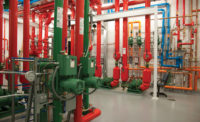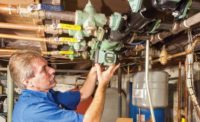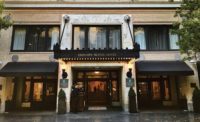Most hotel managers have learned through experience that their toughest, crankiest customer is an unhappy guest at midnight or 5 a.m.
They’ve either just woken up and have to move out post-haste or after a long day of travel need to turn in immediately. But the “hatchet’s in hand” if there’s insufficient pressure — or hot water — for a shower.
Angry hotel guests, at the oddest hours, are known to make quite a ruckus if a hotel’s worst-case scenario coincides with a stressed-out business traveler.
“It’s a situation we work very hard to avoid,” admits Greg Brinkerhoff, director of engineering at the Marriott Kansas City Airport hotel.
According to Brinkerhoff, late arrivers and early risers can push the limits of a hotel’s water heaters and plumbing systems. At his 384-room hotel adjacent to a busy airport, there’s a steady flow of guests at all hours.
“The highest demand for hot water comes between 5 and 6 a.m., and again between 10 p.m. and midnight,” Brinkerhoff adds.
It wasn’t uncommon for hotel managers to get several calls a week from guests displeased about the lack of hot water.
“Unfortunately,” Brinkerhoff says, “the best we could tell them at the time was that hot water ‘was on its way.’”
Hot water woes
For more than two years, the hotel battled domestic hot water issues. As it turns out, a large hydronic valve was used for the original system. The misapplied valve had a 120-second response time and couldn’t actuate quickly to keep up with the changing water pressures present within the hotel.
Because of the valve’s sluggish response time, every time something would go wrong with the pumps, heat exchangers or storage tanks, the entire domestic hot water system would require a time-consuming recalibration. Maintenance was required routinely — a constant source of disruption for the engineering staff.
“More or less, when maintaining the domestic water system, we had to isolate the entire piped network, shutting it down completely,” Brinkerhoff says. “Whenever the hot water mixing valve opened or modulated, the entire system would flood with cold water.
Instead of being able to run the hot water storage tanks at 150° F, facility engineers had to turn the tanks down to produce storage temperatures of only 125°. Also, the capacity of hot water storage plummeted.
Enough is enough
Last winter, facility managers and engineers came together and decided to replace the entire hot water system.
Brinkerhoff was appointed to act as liaison between hotel ownership and the installing contractor. Having worked with him in the past, Brinkerhoff called on Ian Walters, project manager for Kansas City, Mo.-based Lexington Plumbing, a mechanical contracting firm specializing in commercial and industrial work.
Walters had a solution in mind shortly after speaking with Brinkerhoff about the hotel’s domestic hot water issues.
“Ian and I had this discussion about the hotel’s domestic water system and the fact there are so many dynamic changes with the pumps and water pressures,” Brinkerhoff says. “We knew what the hotel needed was a smarter, more responsive valve, especially considering the guests in all 384 rooms had very different schedules.”
Months earlier, Walters had learned about a digital mixing valve made by Powers, a Watts brand.
“They make a smart delivery solution for mixing domestic water in a hot water recirculation loop,” Walters notes. “It’s called IntelliStation. Shortly after learning about them from our rep, we installed one at a large hotel on the other side of town. There, we exceeded the expectations of facility managers, which is a strong confirmation that the technology worked well.”
But Walters didn’t want Brinkerhoff to just take his word for it. He wanted to show him first-hand.
“I went with Ian to another Marriott hotel that had similar hot water issues,” Brinkerhoff says. “They’d installed an IntelliStation digital mixing system there, and I was able to see it in operation and speak to facility managers who more than vouched for the system.”
What he learned was the hotel, which had experienced similar hot water issues, now had a fast-responding, safe and clean domestic hot water system that delivered hot water on demand.
“After hearing maintenance managers validate the technology, testifying that it only took seconds for hot water to get to taps, I was sold,” Brinkerhoff says.
The right rep firm
Hotel guests at the KC Airport Marriott who get hot water fast today will likely never know their comfort and convenience stems from a digital mixing valve presentation given just a few months earlier by Jamey Shibel, who works in outside sales for manufacturers rep firm Mack McLain & Associates, headquartered in Olathe, Kan.
“We presented the IntelliStation’s capabilities at Lexington Plumbing,” Shibel explains. “Very shortly after that, we were writing up an order for one to serve as the focal point for a domestic water retrofit at another Marriott hotel in Kansas City – the one that Ian Walters took Greg Brinkerhoff to before work began at the airport hotel. It was the success of that installation that led to the opportunity with Greg.”
According to Shibel, sizing and specifying a digital mixing station is relatively simple, with key parameters that include overall gpm, load of the building, pipe sizes, height of the structure, number of rooms and fixtures, and size of utilities such as the laundry and kitchen facilities.
Digital mixing and recirculation
Designers of large plumbing systems are now discovering that a digital mixing system is the most effective way to properly deliver mixed water throughout a hot water recirculation loop.
Digital water mixing represents a significant leap in the technology used to control hot water delivery. The approach incorporates a programmable valve or system to quickly process temperature, flow and pressure data, which is obtained from the hot and cold water inlets, mixed outlet and sensors on the mixed-water return. High-speed, responsive electronic actuation modulates a simple valve that allows the setpoint to be electronically controlled and maintained.
Digital mixing allows engineers or facility managers to select a desired hot water temperature and to control and monitor the entire water distribution system. For even greater control, these systems can be installed as part of an ASSE-compliant water distribution system, including point-of-use mixing valves at each fixture in the plumbing system. This ensures hot water storage temperatures can be kept at levels lethal to pathogens, then mixed to safer temperature levels both at points of distribution and use.
Other key advantages to digital mixing include:
-
Supports energy conservation through more efficient water temperature management — and in turn reduces energy costs;
-
Integrates with building automation systems to support integrated building management; and
-
Supports consistent delivery of hot water on demand wherever and whenever it is needed, in accordance with building codes.
Most systems are also field-configurable without the need for a laptop or special software. Digital water mixing and recirculation can easily be integrated into a building automation system to allow facility managers to remotely monitor and control water temperatures.
No mixed emotions here
Since the installation of digital mixing technology at the hotel, facility managers have yet to receive a hot water complaint. Hot water now arrives at taps and showers quickly and at a safe, consistent temperature.
Rather than experiencing the constant headache of boiler room problems and system troubleshooting, Brinkerhoff and his staff merely schedule routine maintenance checks on a six-month cycle.
Varying pressure and temperature fluctuations throughout the hotel’s hot water system no longer pose a threat; they’re managed with ease. While 125° water is sent to guest rooms in an instant, a second hot water loop now runs 150° water to the kitchen and laundry areas where higher temperatures are needed for cooking and cleaning. And, water is safely generated and stored at a germ-scorching 175°.
Four months in with the new digital mixing system, Brinkerhoff says guests are happy.
“And when guests are happy, building owners are happy,” he adds. “There are no mixed emotions or opinion on this investment.”




